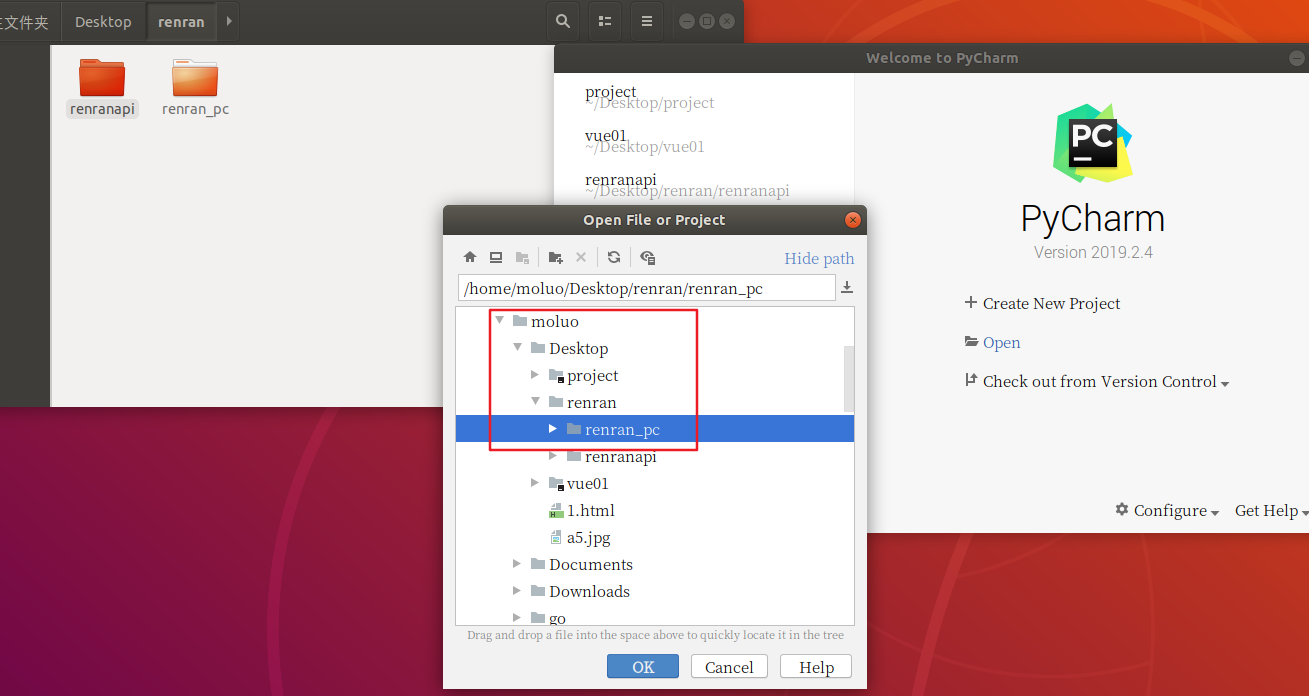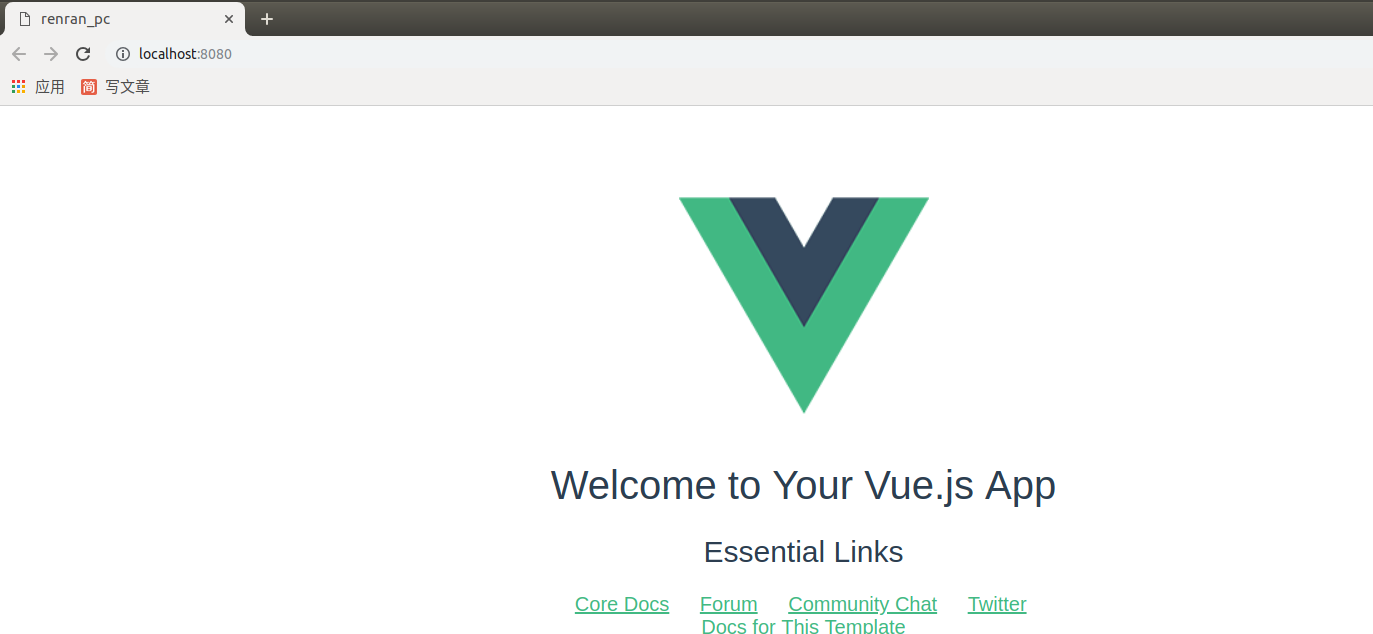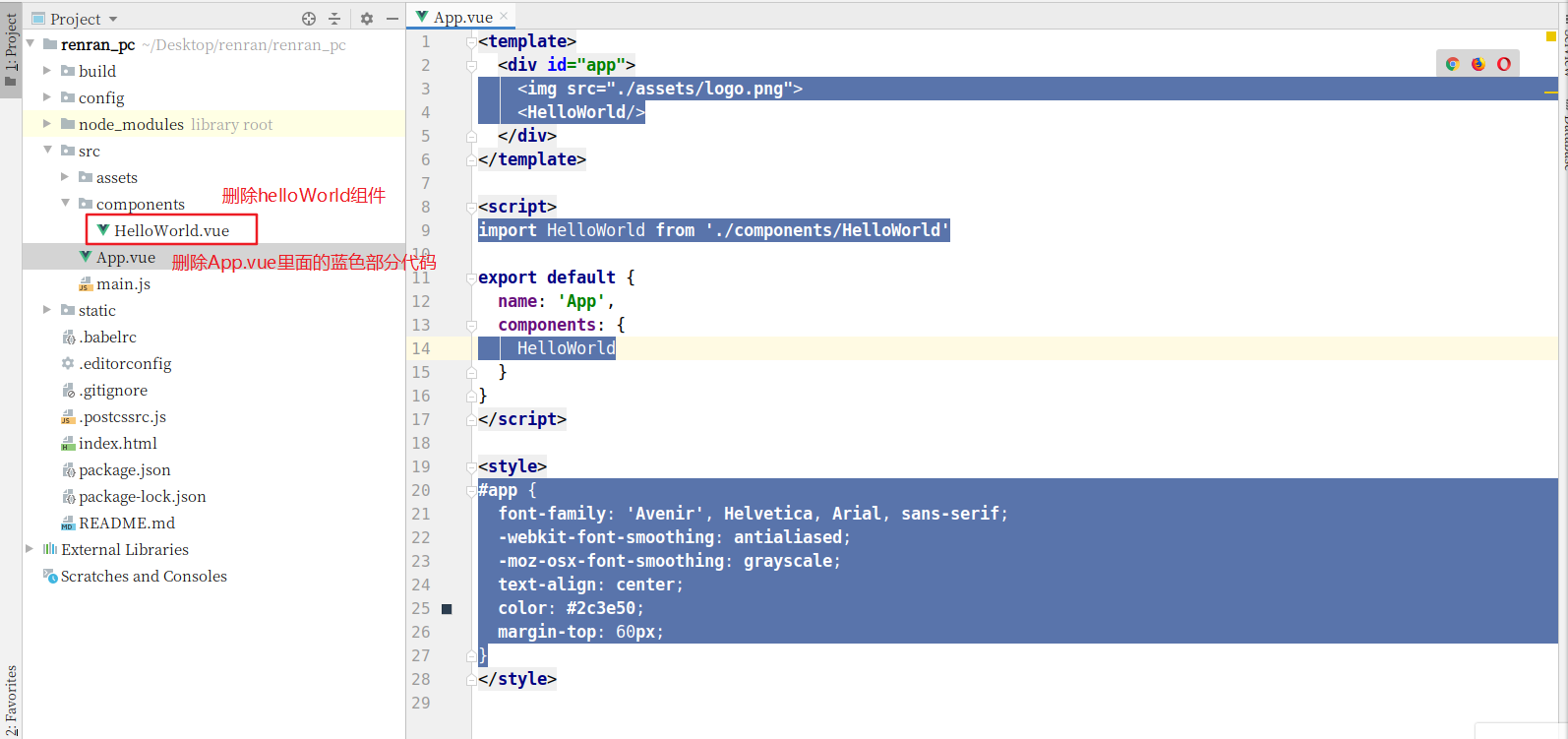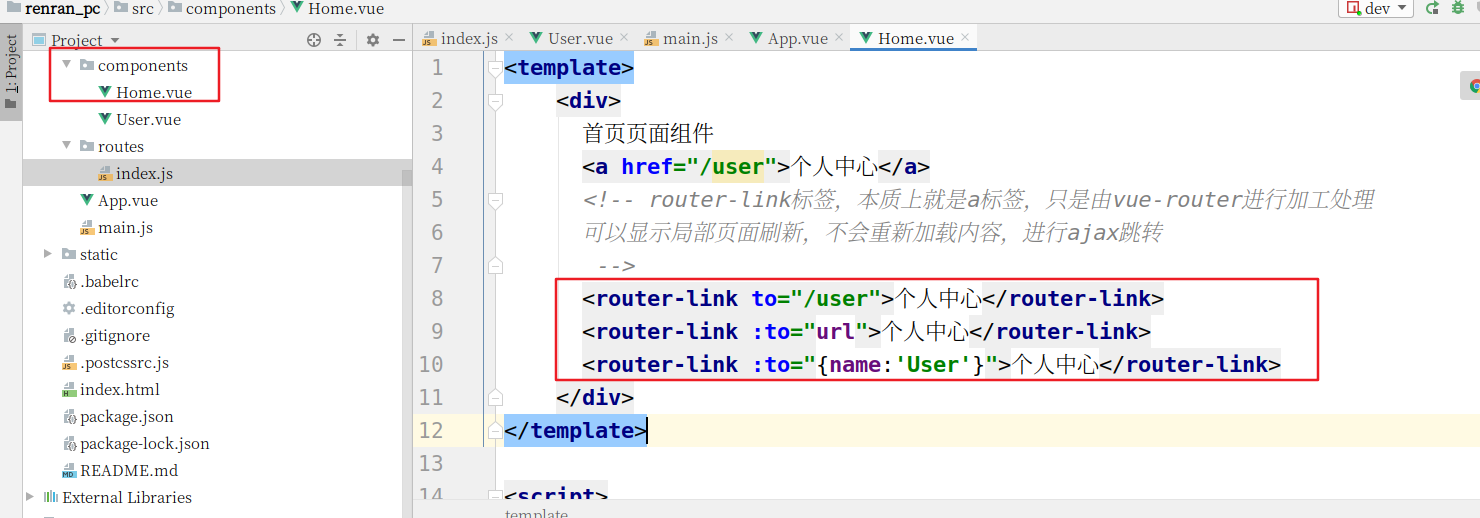Vue 客户端项目搭建
创建项目目录
使用下面的命令初始化创建一个新的 Vue 项目:
cd 项目目录
vue init webpack 项目名称例如,我要把项目保存在桌面下 ~/Desktop/renran,可以如下操作:
cd Desktop/renran
vue init webpack renran_pc
打开项目已经,在 PyCharm 的终端下运行 Vue 项目,查看效果。
npm run dev接下来,我们根据终端上效果显示的对应地址来访问项目(如果有多个 Vue 项目在运行,8080 端口被占据了,服务器会自动改端口,所以根据自己实际在操作中看到的地址来访问)。
访问:http://localost:8080,即可看到 Vue 项目的页面。

初始化项目
清除默认的 HelloWorld.vue 组件和 APP.vue 中的默认模板代码以及默认 css 样式,删除掉下面标注中的所有内容。

App.vue 的最终版本要是这个样子:
<template>
<div id="app">
</div>
</template>
<script>
export default {
name: 'App',
components: {
}
}
</script>
<style>
</style>接下来,我们可以查看效果了,干干净净的一张白纸。

路由 vue-router
官方文档:https://router.vuejs.org/zh/
下载安装路由组件
在终端中输入下面命令之一即可:
npm i vue-router -S
npm install vue-router --save说明:这两条命令完全等效,第一条命令是第二条命令的简写,install 可简写成 i。--save 意思是保存安装包到本地,以后再次安装可以不必联网,直接从本地获取,可简写为 -S。
配置路由
初始化路由对象
在 src 目录下创建 routes 路由目录,在 router 目录下创建 index.js 路由文件
index.js 路由文件中,编写初始化路由对象的代码 .
// 1. 引入vue和vue-router组件核心对象,并在vue中通过use注册vue-router组件
import Vue from "vue";
import Router from "vue-router";
Vue.use(Router);
// 2. 暴露vue-router对象,并在vue-router里面编写路由,提供给main.js调用
export default new Router({
// 设置路由模式为‘history’,去掉默认的#
mode: "history",
routes:[
// 路由列表
]
})注册路由信息
打开 main.js 文件,把 router 路由规则对象注册到 vue 中,分为引入和注册两步,代码:
// The Vue build version to load with the `import` command
// (runtime-only or standalone) has been set in webpack.base.conf with an alias.
import Vue from 'vue'
import App from './App'
import router from './router/index' // 1、引入,这样引入文件那么会直接拿到这个文件中export default后面的对象,export default的意思是将对象暴露出去,让别人可以引入
// import router from '@/router/index' // @符号表示的是src的目录路径,这样写起来更靠谱一些,因为引入src目录里面的内容的时候就不需要知道当前文件和src目录里面的文件隔着几层了
Vue.config.productionTip = false
/* eslint-disable no-new */
new Vue({
el: '#app',
router, // 2、注册
components: { App },
template: '<App/>'
});在视图中显示路由对应的内容
在 App.vue 组件中,添加显示路由对应的内容。代码:
<template>
<div id="app">
<!-- 标签名必须是这个rouer-view -->
<router-view/>
</div>
</template>
<script>
export default {
name: 'App',
components: {},
}
</script>
<style>
</style>注意:如果在 vue 创建项目的时候,设置安装 vue-router,则项目会自动帮我们生成上面的 router 目录和 index.js 里面的代码,以及自动到 main.js 里面注册路由对象。
路由对象提供的操作
在我们安装注册了 vue-router 组件吗以后,vue-router 在 vue 项目中会帮我们在全局范围内所有组件里面创建 2 个对象给我们使用:
this.$router,可用于在 js 代码中进行页面跳转。this.$route,可用于获取地址栏上面的 url 参数。
页面跳转
在 vue-router 提供的操作中, 进行页面跳转有 2 种方式:
使用
<router-link to="url地址">来跳转在
<script>中使用this.$router.push(url地址)来跳转在
<script>中还可以使用this.$router.go(整数),表示跳转返回上一页或者上几页,下一个或者下几页
router-link 标签
我们可以在 Home.vue 组件中,使用 router-link 跳转到 User.vue 组件中。
vue-router 除了可以进行组件和 url 地址的绑定(即访问特定的 URL 会返回不同的页面)以外,还可以实现不同组件的页面跳转。
routes/index.js 的代码如下:
// 1. 引入vue和vue-router组件核心对象,并在vue中通过use注册vue-router组件
import Vue from "vue";
import Router from "vue-router";
Vue.use(Router); // Router是类
// 2. 暴露vue-router对象,并在vue-router里面编写路由,提供给main.js调用
// 导入组件
// import 组件名 from "../components/组件名"
import Home from "../components/Home";
import User from "../components/User"; // 当然要有一个User.vue文件,随便写就行
export default new Router({
mode:"history", // 路由地址的显示模式: 默认hash,表示地址栏上面出现#
routes:[
// {
// name:"路由名称[对应组件的name值,将来用于跳转页面]",
// path: "访问url路径",
// component: 组件名
// },
{
name:"Home",
path: "/",
component: Home
},{
name:"User",
path: "/user",
component: User
},
],
});Home.vue 代码:
<template>
<div>
首页页面组件
<a href="/user">个人中心</a>
<!-- router-link标签,本质上就是a标签,只是由vue-router进行加工处理
可以显示局部页面刷新,不会重新加载内容,可进行ajax跳转 -->
<router-link to="/user">个人中心</router-link>
<router-link :to="url">个人中心</router-link>
<router-link :to="{name:'User'}">个人中心</router-link>
</div>
</template>
<script>
export default {
name: "Home",
data(){
return {
url: "/user",
}
},
methods:{
}
}
</script>
<style scoped>
</style>
上面代码的运行效果为:

this.$router.push() 跳转
<template>
<div>
首页页面组件
<a href="/user">个人中心</a>
<router-link to="/user">个人中心</router-link>
<router-link :to="url">个人中心</router-link>
<router-link :to="{name:'User'}">个人中心</router-link>
<button @click="jump">个人中心</button>
</div>
</template>
<script>
export default {
name: "Home",
data(){
return {
url: "/user",
}
},
methods:{
jump(){
// 开发中可以先进行权限,登录之类的判断,然后再进行跳转
// this.$router.back(); // 返回上一页,本质上就是 location.back()
// this.$router.go(-1); // 返回上一页,本质上就是 location.go()
// this.$router.forward(); // 跳转到下一页,本质上就是 location.forward()
this.$router.push("/user"); // 跳转到站内的制定地址页面中,本质上就是 location.href
// 注意,this.$router.push() 不能跳转到其他网站。如果真的要跳转外站,则使用location.href="站外地址,记得加上http://协议"
}
}
}
</script>
<style scoped>
</style>参数传递
vue-router 提供了 this.$route,可以让我们接受来自其他页面的附带参数。参数有 2 种:
查询字符串(query string),就是地址栏上面
?号后面的参数,例如:
http://localhost:8008/user?name=xiaoming&pwd=123,这里name=xiaoming&pwd=123就是查询字符串参数。路由参数(router params),就是地址栏上面路由路径的一部分,
例如:
http://localhost:8080/user/300/xiaoming,此时,300 属于路由路径的一部分,这个 300 就是路由参数,当然,xiaoming 或者 user 也可以理解是路由参数,就是看我们的页面中是否需要接收而已。
获取查询字符串
必须先有一个页面跳转发送参数。例如,在 Home 组件中跳转到 User 组件中,需要传递 name 和 pwd 查询字符串。
Home.vue代码:<template> <div> 首页页面组件 <router-link :to="`/user?name=${name}&pwd=${pwd}`">查询字符串参数</router-link> <router-link :to="'/user?name='+name+'&pwd='+pwd">查询字符串参数</router-link> </div> </template> <script> export default { name: "Home", data(){ return { name: "xiaoming", pwd: "123", } }, } </script> <style scoped> </style>可以在下一个页面中,这里代表的就是 User 组件,接收来自 Home 组件的参数。
<template> <div> 用户中心页面组件 </div> </template> <script> export default { name: "User", created() { // 接收地址栏上面的参数 // this.$route是vue-router提供的一个用于接收地址参数的对象。 // 经过main.js里面注册router对象以后, // 将来在所有的子组件中,可以通过this.$route来获取参数或者通过this.$router跳转页面 // 查询字符串参数 // query是this.$route里面的一个数组,this.$route会自动收集地址栏上所有的参数保存到query里面 // let name = this.$route.query.name; // let pwd = this.$route.query.pwd; // console.log(`name=${name}&pwd=${pwd}`); // ``里面,${}圈住的内容会被js当成变量来解析 } } </script> <style scoped> </style>
获取路由参数
例如:我们用户的界面都是一样的,但是每一个用户来到自己的页面中,显示的内容肯定都是不一样的,此时,我们需要使用不同的路径来区分不同的用户。这时候,可以在路由路径中使用路由参数表示不同用户的 id。
例如:我们就需要设置一个 route/index.js 中路由信息里面,哪一段路由属于路由参数。
src/routes/index.js 设置路由参数。
import Vue from "vue";
import Router from "vue-router";
Vue.use(Router);
import Home from "../components/Home";
import User from "../components/User";
export default new Router({
mode:"history",
routes:[
{
name:"Home",
path: "/",
component: Home
},{
name:"User",
path: "/user/:id/img-:img_id",
component: User
},
],
});然后我们就是在 Home 中如果需要转到 User 里面。
Home.vue 代码:
<template>
<div>
首页页面组件
<router-link to="/user/100/img-10086">路由参数</router-link>
</div>
</template>
<script>
export default {
name: "Home"
}
</script>
<style scoped>
</style>User.vue,组件中可以通过this.$route.params接收路由参数。
<template>
<div>
用户中心页面组件
</div>
</template>
<script>
export default {
name: "User",
created() {
// 接收地址栏上面的参数
// this.$route是vue-router提供的一个用于接收地址参数的对象。
// 经过main.js里面注册router对象以后,
// 将来在所有的子组件中,可以通过this.$route来获取参数或者通过this.$router跳转页面
// 查询字符串参数
// query是this.$route里面的一个数组,this.$route会自动收集地址栏上所有的参数保存到query里面
// let name = this.$route.query.name;
// let pwd = this.$route.query.pwd;
// console.log(`name=${name}&pwd=${pwd}`); // ``里面,${}圈住的内容会被js当成变量来解析
// 路由参数
// params是this.$route里面的一个数组,this.$route会自动收集路由列表中已经标记为路由参数所有内容保存到params中
let id = this.$route.params.id;
console.log(id);
let img_id = this.$route.params.img_id;
console.log(`img_id = ${img_id}`);
}
}
</script>
<style scoped>
</style>ElementUI
对于前端页面布局,我们可以使用一些开源的UI框架来配合开发,常用的 UI 框有:bootstap,H-ui 框架,lay-UI 框架,Amaze UI,zui 框架,ElementUI.
Vue 开发前端项目中,比较常用的就是 ElementUI。
ElementUI 是饿了么团队开发的一个 UI 组件框架。这个框架提前帮我们提供了很多已经写好的通用模块,我们可以在 Vue 项目中引入来使用。这个框架的使用类似于我们前面学习的 bootstrap 框架。也就是说,我们完全可以把官方文档中的组件代码拿来就用。有定制性的内容,可以直接通过样式进行覆盖修改就可以了。

中文官网:http://element-cn.eleme.io/#/zh-CN
快速入门文档:http://element-cn.eleme.io/#/zh-CN/component/quickstart
安装 ElementUI
项目根目录执行以下命令:
npm i element-ui -S上面的命令等同于 npm install element-ui --save
执行命令效果:

配置 ElementUI 到项目中
在 main.js 中导入 ElementUI,并调用。代码:
// elementUI 导入
import ElementUI from 'element-ui';
import 'element-ui/lib/theme-chalk/index.css';
// 调用插件
Vue.use(ElementUI);成功引入了 ElementUI 以后,接下来我们就可以开始进入前端页面开发。
首页
首页采用了上下页面布局,首页是导航栏、轮播图。。。脚部等几个小模块。所以我们可以把首页作为一个组件进行开发,然后把首页的这些小模块作为单独的组件来进行开发。
创建首页组件
在 src/components 目录下创建文件 Home.vue
代码:
<template>
<div id="home">
首页
</div>
</template>
<script>
export default {
name:"Home",
data(){
return {
}
}
}
</script>
<style scoped>
</style>创建首页对应的路由
在 router/index.js 中引入 Home 组件,并设置 Home 组件作为首页路由。
代码:
import Vue from "vue"
import Router from "vue-router"
// 后面这里引入可以被用户访问的页面组件
import Home from "../components/Home"
Vue.use(Router);
export default new Router({
// 路由跳转模式,注意使用 history
mode: "history",
// 路由规则
routes:[
{
// name:"路由别名",
name:"Home",
// path: "路由地址",
path: "/",
// component: 组件类名,
component: Home,
},
]
})